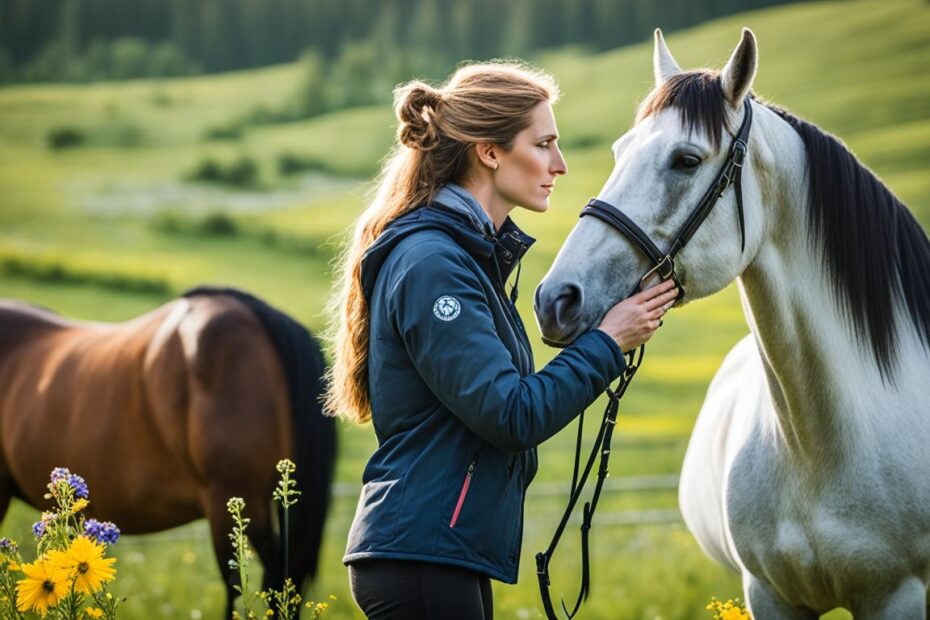Horses have captivated the human imagination for centuries, with their majestic presence, graceful movements, and deep-rooted connection to our history. Hidden within the equine realm lies a wealth of ancient knowledge and techniques that have long been revered, yet often misunderstood.
This article invites you to embark on a captivating journey, where we will unravel the mysteries of decoding ancient horse whispering techniques and explore the profound equine communication methods that have been passed down through generations.
Through a deeper understanding of natural horsemanship, horse behavior psychology, and the intricate horseman-horse bond, we will unveil the lost art of effective equine communication.
Discover how to interpret nonverbal cues and subtle signals, master calming techniques for challenging situations, and cultivate a lasting trust-building connection with your equine partner. Immerse yourself in the captivating world of herd dynamics and gentle training methods, as we unlock the secrets to a truly harmonious relationship between horse and human.
Key Takeaways
- Explore the fascinating world of ancient horse whispering techniques and unlock the secrets of effective equine communication.
- Develop a deeper understanding of horse behavior, body language, and herd dynamics to build trust and enhance your bond with your equine partner.
- Discover calming techniques and gentle training methods to create a harmonious relationship between horse and human.
- Interpret nonverbal cues and subtle signals to better understand your horse’s needs and preferences.
- Embrace the principles of natural horsemanship and cultivate a lasting, trust-based connection with your equine companion.
The Art of Equine Communication
Horses are remarkable creatures, and understanding their unique form of communication is crucial for building a strong bond and fostering a harmonious relationship.
Exploring the nonverbal language of horses and delving into the intricate dynamics of equine herds can provide invaluable insights for equestrians and horse enthusiasts alike.
Exploring the Nonverbal Language of Horses
Horses rely heavily on nonverbal cues to convey their thoughts, emotions, and intentions. From the subtle twitches of their ears to the expressive movements of their tails, these equine signals hold the key to interpreting their state of mind.
By learning to read these nonverbal cues, individuals can gain a deeper understanding of their horse’s behavior and respond appropriately to their needs.
Understanding Herd Dynamics and Hierarchies
Horses are highly social animals, and their behavior is deeply influenced by the complex hierarchy within their herds. Recognizing the intricate dynamics and power structures that govern equine groups can provide invaluable insights into the psychology of horse behavior.
By understanding the roles and interactions within the herd, equestrians can better anticipate their horse’s reactions and cultivate a more harmonious partnership.
Mastering the art of equine communication is a journey of discovery, but the rewards are immense. By delving into the nonverbal cues and herd dynamics of these magnificent creatures, individuals can develop a more profound understanding of the equine mind and forge stronger, more meaningful connections with their equine companions.
Decoding Ancient Horse Whispering Techniques
In the realm of natural horsemanship, the ancient art of “horse whispering” has long captivated the equestrian community. This time-honored approach to training and communicating with horses offers a unique insight into the equine psyche, bridging the gap between human and equine understanding.
By delving into the core principles of this holistic practice, we can unlock the secrets to building stronger, more harmonious bonds between riders and their equine partners.
At the heart of horse whispering lies a profound respect for the horse’s natural instincts and behaviors. Unlike traditional training methods that often rely on force or fear, the horse whisperer’s approach emphasizes patience, empathy, and a deep connection with the animal.
By learning to “speak the language” of horses, practitioners can establish trust, reduce stress, and foster a collaborative partnership that benefits both the human and the equine.
The key elements of the horse whispering technique include:
- Nonverbal communication: Observing and interpreting the subtle body language and social cues of horses to understand their needs and preferences.
- Gentle training methods: Employing positive reinforcement and minimizing the use of harsh tools or techniques, thereby creating a stress-free learning environment.
- Herd dynamic awareness: Recognizing and respecting the complex social structures and hierarchies within equine herds, allowing for a more natural and organic training process.
- Intuitive connection: Developing a deep, intuitive understanding of the horse’s emotional state and responding with empathy and patience.
By mastering these core principles, practitioners of natural horsemanship and equine training can unlock the true potential of their equine partners, fostering a partnership built on trust, respect, and mutual understanding.

As we continue to explore the rich history and enduring legacy of horse whispering, we can gain valuable insights into the subtle art of communicating with these magnificent creatures.
By embracing the gentle training methods and natural horsemanship principles of the horse whisperer, we can unlock new dimensions of the human-equine bond, paving the way for a more harmonious and enriching experience for all involved.
Mastering the Art of Natural Horsemanship
Connecting with your equine companion is the foundation of natural horsemanship, a philosophy that emphasizes building a trusting and mutually respectful relationship.
At the heart of this approach lies the principle of understanding the equine language and harnessing the power of nonverbal communication to forge a deeper horseman-horse bond.
Building Trust and Rapport with Your Horse
Mastering the art of natural horsemanship requires a patient and compassionate approach. It’s about creating a safe space where your horse feels heard, understood, and empowered to express their authentic selves. Here are some trust-building exercises to help you cultivate this connection:
- Spend quiet, uninterrupted time with your horse, allowing them to get comfortable with your presence.
- Engage in gentle grooming sessions, paying close attention to your horse’s body language and preferences.
- Incorporate positive reinforcement techniques, such as rewarding desired behaviors with treats or praise.
- Practice patient, deliberate movements and avoid sudden actions that may startle or intimidate your horse.
- Engage in mutual respect-based activities, such as leading your horse without pressure or expectation.
By embracing these principles, you’ll unlock the true potential of your horseman-horse bond, fostering a relationship built on trust, understanding, and a profound mutual respect.
The Psychology of Horse Behavior
Understanding the psychological aspects of horse behavior is crucial for developing effective communication and training strategies.
Equine psychologists have delved deep into the cognitive and emotional processes that drive a horse’s actions and reactions. By exploring this fascinating realm, horse enthusiasts can gain valuable insights that enhance their relationships with these majestic animals.
At the heart of horse behavior psychology is the recognition that horses are highly intelligent and social creatures. They possess complex emotional lives, with the ability to experience a range of feelings, from fear and anxiety to contentment and joy.
Recognizing these emotional states and understanding the underlying motivations can help horse owners and trainers respond with empathy and understanding.
Exploring Equine Cognition
Horses are renowned for their remarkable memory and problem-solving abilities. Studies have shown that they can remember specific individuals, locations, and even past experiences for extended periods. This cognitive capacity allows them to learn and adapt to new situations, making them capable of forming strong bonds with their human partners.
Understanding Herd Dynamics and Hierarchy
Horses are inherently social animals, living in close-knit herds with complex hierarchical structures. Comprehending the dynamics within a herd, including the roles of dominant and submissive individuals, can shed light on a horse’s behavior and how it may respond in various situations. Recognizing these social cues can help horse handlers navigate interactions with their equine partners more effectively.
| Key Aspects of Horse Behavior Psychology | Importance |
|---|---|
| Emotional Intelligence | Recognizing and responding to a horse’s emotional state can strengthen the human-animal bond and improve training outcomes. |
| Cognitive Abilities | Understanding a horse’s memory, problem-solving skills, and capacity to learn can optimize training and handling techniques. |
| Herd Dynamics and Hierarchy | Comprehending a horse’s social interactions and position within a herd can enhance communication and trust-building. |
By delving into the psychological aspects of horse behavior, equine enthusiasts can develop a deeper understanding of these magnificent creatures. This knowledge can translate into more effective communication, training, and the cultivation of lasting, meaningful relationships between humans and horses.

Interpreting Equine Body Language
Effective communication with horses is not limited to verbal cues. In fact, understanding and interpreting the nonverbal signals they convey through their body language is essential for building a strong bond and fostering a harmonious relationship.
By mastering the art of equine body language interpretation, horse enthusiasts can gain invaluable insights into their equine companions’ emotional states and behavioral patterns.
Recognizing Subtle Cues and Signals
Horses are highly expressive animals, and their body language is a rich tapestry of subtle cues and signals that convey a wealth of information.
From the position of their ears and the movement of their tails to the tension in their muscles and the direction of their gazes, every aspect of a horse’s physical demeanor can offer valuable clues about their mood, intentions, and overall well-being.
By observing these equine body language patterns, horse owners and handlers can learn to anticipate potential problems, respond appropriately to their horse’s needs, and create a more harmonious and trusting partnership.
This deep understanding of nonverbal cues interpretation and equine body language is a hallmark of skilled horse behavior psychology and the foundation of successful equine interactions.
| Body Language Cue | Possible Meaning |
|---|---|
| Ears forward | Attentive, engaged, or curious |
| Ears pinned back | Aggressive, irritated, or threatened |
| Tail swishing | Nervous, agitated, or annoyed |
| Stomping feet | Defensive, protective, or ready to flee |
By familiarizing themselves with the nuances of equine body language, horse enthusiasts can deepen their understanding of their equine partners, anticipate their needs, and respond with empathy and skill, ultimately enhancing the horse behavior psychology and the overall equine experience.
Calming Techniques for Challenging Situations
Horses are sensitive creatures, and even the most well-trained equine can become anxious or upset in certain situations.
As natural horsemanship enthusiasts, it’s crucial to have a repertoire of calming techniques to soothe and reassure our beloved companions. By mastering these methods, we can not only navigate challenging moments with ease but also deepen the bond between the horseman and the equine.
One of the most effective calming techniques is the use of calming vocal tones. Speaking in a soft, gentle voice can have a profound impact on a horse’s emotional state, helping to alleviate stress and promote a sense of safety.
Additionally, incorporating slow, rhythmic movements can further reinforce this calming effect, allowing the horse to feel secure and comforted.
Another valuable technique is the implementation of calming scents. Certain essential oils, such as lavender or chamomile, have been shown to have a soothing effect on horses, helping to reduce anxiety and promote relaxation. Incorporating these scents into the horse’s environment or even applying them directly to the animal can be a powerful tool in managing challenging situations.
Lastly, the practice of natural horsemanship, which emphasizes building trust and understanding between the horseman and the horse, can be an invaluable asset in calming challenging situations.
By fostering a strong, positive relationship with our equine companions, we can more effectively communicate our intentions and provide the reassurance they need to overcome their fears and anxieties.
Ultimately, the key to navigating challenging situations with our horses lies in our ability to understand their needs and respond with empathy, patience, and a repertoire of effective calming techniques. By embracing these methods, we can create a harmonious partnership that transcends the challenges we may face, strengthening the bond between the horseman and the equine.
Enhancing the Horseman-Horse Bond
Building a strong and meaningful bond between the horseman and the horse is essential for achieving harmony, trust, and effective communication.
By developing a deeper connection, riders can unlock the full potential of their equine partners and create a partnership rooted in mutual understanding and respect.
Fostering Trust through Bonding Exercises
One of the key aspects of enhancing the horseman-horse bond is engaging in trust-building exercises. These activities help to establish a foundation of trust and foster a sense of safety and security between the rider and the horse. Some effective trust-building exercises include:
- Groundwork exercises, such as leading, grooming, and desensitization
- Slow and calm interactions, allowing the horse to set the pace
- Spending quiet time together, simply being present with the horse
- Offering treats and rewards to reinforce positive associations
By consistently engaging in these trust-building exercises, the horseman can gradually earn the horse’s confidence and build a stronger bond over time.
Nonverbal Communication and Empathy
Developing a deeper connection with the horse also involves understanding and interpreting their nonverbal cues. Observing the horse’s body language, facial expressions, and subtle behaviors can provide valuable insights into their emotional state and allow the horseman to respond accordingly.
By cultivating empathy and attuning to the horse’s needs, the horseman can foster a more harmonious and rewarding relationship.
| Technique | Description | Benefits |
|---|---|---|
| Equine-Assisted Activities | Engaging in activities like therapeutic riding, groundwork, or equine-assisted learning can deepen the bond between the horseman and the horse. | Improves communication, trust, and emotional connection. |
| Mindfulness Practices | Incorporating mindfulness techniques, such as slow and deliberate movements, can help the horseman become more attuned to the horse’s needs and emotions. | Enhances emotional awareness, reduces stress, and fosters a calmer, more connected partnership. |
| Consistent Routine | Establishing a consistent routine for feeding, grooming, and interacting with the horse can create a sense of safety and predictability, strengthening the bond. | Builds trust, reduces anxiety, and reinforces the horseman’s role as a reliable caregiver. |
By incorporating these techniques and strategies, horsemen can enhance the bond with their equine partners, leading to a more fulfilling and rewarding equestrian experience.
Embracing Gentle Training Methods
In the realm of equine training, a gentle approach often proves more effective and rewarding than traditional, forceful techniques. By embracing gentle training methods and the principles of natural horsemanship, equine enthusiasts can foster a positive and collaborative partnership with their beloved equine companions.
At the heart of this gentle approach lies the recognition that horses, like all sentient beings, respond best to kindness, patience, and mutual understanding.
Through the implementation of gentle training methods, horse owners can build an unbreakable bond with their animals, based on trust, respect, and a shared sense of purpose.
By eschewing harsh punishments or intimidation tactics, and instead focusing on positive reinforcement and consistent communication, gentle training methods allow both the horseman and the horse to thrive.
This holistic approach not only enhances the overall well-being of the animal but also cultivates a deeper, more fulfilling connection between the two, paving the way for a harmonious and rewarding relationship.
FAQ
What are the core principles of ancient horse whispering techniques?
Ancient horse whispering techniques are rooted in building trust, developing a deeper bond, and enhancing the overall connection between the horseman and the horse.
These time-honored methods focus on understanding the horse’s innate behaviors, body language, and herd dynamics to create a more harmonious relationship.
How can I interpret the nonverbal communication of my horse?
Mastering the art of interpreting equine body language is crucial for effective communication. By recognizing subtle cues and signals, such as ear positioning, tail swishing, and changes in facial expressions, you can better understand your horse’s emotional state and respond accordingly.
What are the benefits of natural horsemanship compared to traditional training methods?
Natural horsemanship emphasizes a gentler, more compassionate approach to training, focusing on trust-building exercises and fostering a mutual understanding between the horseman and the horse. This contrasts with more traditional, forceful methods, which can compromise the horse’s well-being and the overall relationship.
How can I develop a deeper connection with my horse?
Enhancing the horseman-horse bond is crucial for creating a harmonious partnership. Techniques such as groundwork exercises, desensitization, and building mutual trust can help you develop a deeper connection and understanding with your equine companion.
What calming techniques can I use in challenging situations with my horse?
When faced with a horse that is anxious or upset, various calming techniques can be employed to soothe and reassure the animal. These include using a soft, gentle tone of voice, slow breathing exercises, and introducing familiar objects or scents to create a sense of security and comfort.
How can understanding herd dynamics and hierarchies help me communicate better with my horse?
Horses are highly social animals with complex herd structures and hierarchies. By understanding the dynamics within equine herds, you can better interpret your horse’s behaviors and responses, allowing you to adapt your communication and training approaches to suit their individual needs and preferences.
What are the psychological aspects of horse behavior that I should be aware of?
Horses have unique cognitive and emotional processes that shape their behaviors and reactions. By exploring the psychology of equine behavior, you can develop more effective communication and training strategies, tailored to your horse’s individual personality and temperament.

